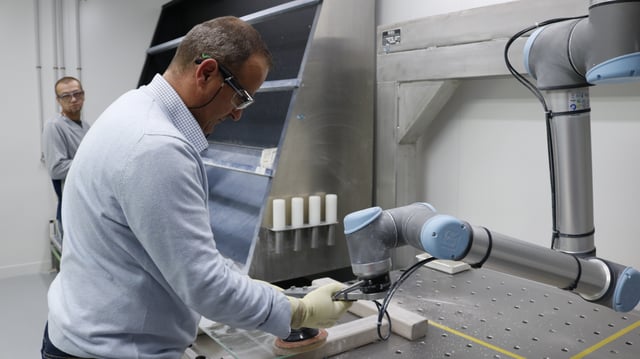5 Essential Robotic Cell Components

The book Lean Robotics – A Guide to Making Robots Work in Your Factory identifies five main components for high-level conceptualization of a robotic cell: robot, tooling, sensors, safety measures, and software. At the early, high-level concept stage, the objective is to identify robotic components you can use to evaluate the robotic cell. This article will explore some important considerations for each of these components.
Choosing a robot for your robotic cell
The robot is your engine and platform. If you overstate the requirements you could end up with something bigger and bulkier than necessary – using a truck with a V8 engine to haul something you could have thrown in the back of a compact car. If you underestimate, you’ll end up with something that can’t accomplish the task and ends up slowing down the process. Keep your task mapping results close by to stay on track with what you genuinely need. What payload is required? Are there any size or footprint constraints? Where/how does an object need to be picked up, and where/how is it released?
You’ll need to consider the how the robot arm or body needs to maneuver to specify the axis or degrees of freedom. The way the arm moves also affects the reach. With humans you’re stuck with the same joint constraints on everyone, but robotic arms have joints and motors that can allow movements humans can’t do. It’s worthwhile to look at videos and demos so you can think in terms of robotic capabilities, and not just try to mimic a human.
See the Collaborative Robot Buyer’s Guide for a review of 34 popular and emerging collaborative robots, including key features, targeted applications, and main specifications.
Identifying the tooling needed in your robotic cell
Generally speaking, robots don’t hold tools with robot hands. The end effector is the tool. Researching and comparing the requirements and capabilities of end effectors will give you an immense appreciation for the efficiency and precision of robotic tools and for the ability of human hands to do things like pick up different-size eggs. Again, it’s worthwhile to watch videos and see demos of end effectors to think in terms of robotic capabilities, not human replacement.
Which sensors should you use in your robotic cell?
Sensors provide flexibility, but they can also increase complexity, so you want to keep your choice of sensors as simple as possible to successfully accomplish the task. Sensors are an important consideration not just for task completion, but also for safety. Collision detection and speed/separation monitoring sensors can be used to help collaborative robots operate safely in proximity to humans. Consider whether you need to robot to slow down or stop when it detects a presence or if you only need it to stop after contact. Check which safety sensors are built in to the robot you’re using.
For task completion, does the operation require part detection or vision sensors? Without part detection, a gripper won’t know if it actually picked something up. Some end effectors may have integrated sensors such as part detection. Again, these components need to be looked at together, not just individually. If vision is required, what does the robot need to detect? Colors? 2D? 3D?
Learn more about applications that can benefit from sensors in the ebook Adding Extra Sensors – How to do Even More with Collaborative Robots.
How to determine the safety measures needed in your robotic cell
A comprehensive risk assessment is crucial to provide the necessary safety measures. In some cases, the safety sensors built in to the robot can provide a safe environment, but in other cases, additional measures such as guarding must be taken. It’s important to look at the entire cell to determine safety requirements.
Robotic cell software and communication considerations
There are several software issues to consider. First, look at the essential communication requirements, such as how the robot interacts with its own components, e.g. communication between the robot and its end effectors and sensors. Communication requirements can also include how the robot needs to convey information within and outside the cell.
Next, look at specifics. What software can be used with the selected robot? Are there drivers for tooling? What level of programming expertise will be required? You don’t need to figure everything out at the high-level concept stage, but it is useful to identify areas that could be prone to complexity, and that will need further investigation and refinement as you go through the deployment process.
Even at a high-concept level, evaluating components can result in seeing how much more there is to know. Prevent discouragement by looking at how much you’ve learned and not trying to become an overnight expert. Share the insights gained from this stage with your team before proceeding to the next step. To learn more about using lean robotics to deploy a robotic cell, visit leanrobotics.org.









Leave a comment